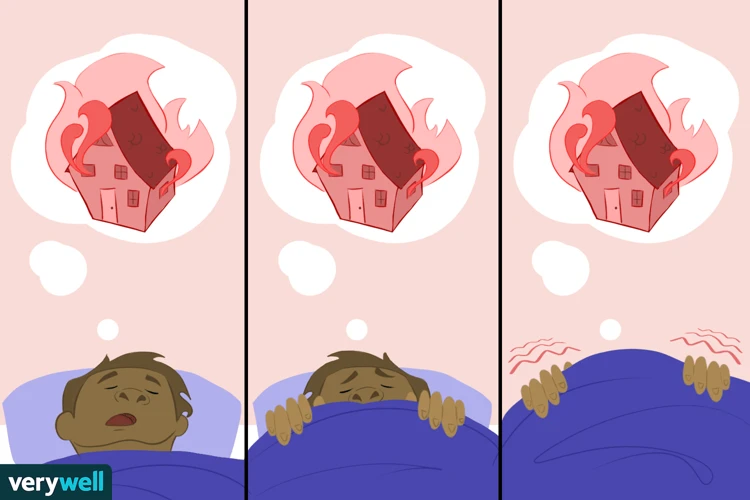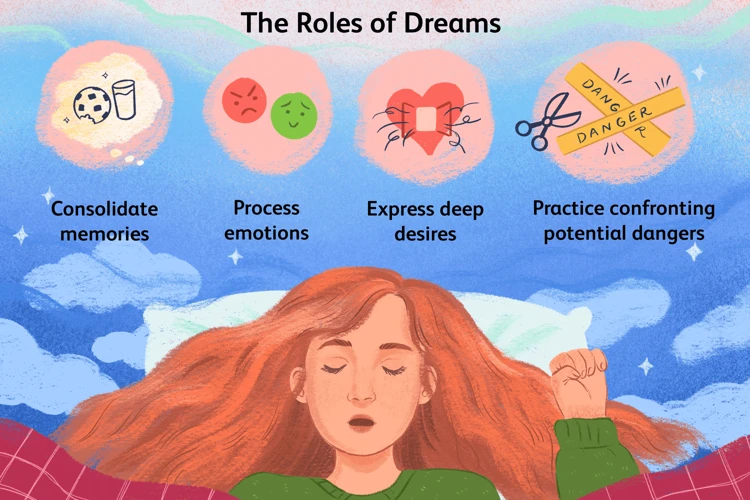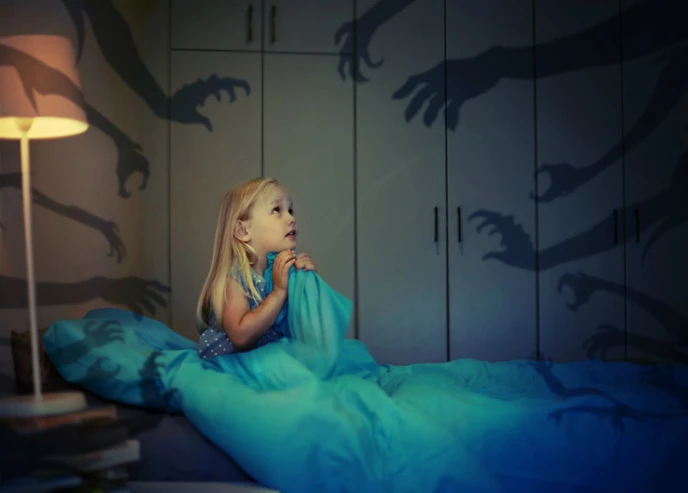As parents, we want nothing more than for our children to have peaceful nights of sleep. However, it can be disconcerting when our little ones wake up in the middle of the night, drenched in sweat and trembling from nightmares. Nightmares in children are a common occurrence, but knowing when to be concerned can be confusing. In this comprehensive article, we will delve into the world of nightmares, exploring their definition, prevalence, causes, signs, and symptoms. We will also discuss the impact of nightmares on children and provide guidance on when to seek professional help. Additionally, we will share tips on how to prevent nightmares and create a safe and comforting environment for our little dreamers. So, let’s unravel the mysteries behind nightmares and ensure that our children’s nights are filled with calmness and tranquility.
What are Nightmares?

Nightmares are unsettling and vivid dreams that can cause intense fear or distress, often waking the individual from sleep in a state of panic. These nocturnal terrors are more common in children than in adults and can occur during any stage of sleep. Nightmares usually involve scenarios that are threatening or distressing, such as being chased or attacked. They can leave a lasting impact on a child’s well-being, affecting their sleep patterns and overall emotional state. Understanding the nature of nightmares is crucial in determining when to be concerned and take appropriate action. To explore more about the role of frequent nightmares in sleep disorders, click here.
Definition of Nightmares
Nightmares can be defined as unsettling and distressing dreams that occur during sleep. They are characterized by intense fear, anxiety, or a sense of impending danger. These vivid and emotionally charged dreams often involve situations that are threatening or traumatic, such as being chased, attacked, or witnessing a frightening event. Nightmares are different from regular dreams in that they evoke a strong emotional response, causing the individual to wake up feeling frightened or disturbed. During a nightmare, the individual may experience rapid breathing, increased heart rate, and sweating. While nightmares can happen to anyone, they are more prevalent in children, particularly during periods of intense imagination and cognitive development. It is important to note that not all bad dreams are considered nightmares, as occasional disturbing dreams are a normal part of the sleep cycle. To learn more about the causes of recurring nightmares, click here. Additionally, certain foods and beverages consumed before bed have been linked to increased nightmare frequency, and avoiding them may help promote better sleep. Discover the nightmare foods to avoid by clicking here.
Types of Nightmares
There are several types of nightmares that children may experience. Each type of nightmare can vary in content and theme, but they all share the common feature of causing fear or distress. Here are some of the common types of nightmares:
- Monster or Creature Nightmares: These nightmares often involve encounters with imaginary creatures or monsters. Children may dream about being chased or attacked by these frightening creatures, leading to feelings of terror during sleep.
- Natural Disaster Nightmares: Natural disasters such as earthquakes, floods, or tornadoes can be the focus of nightmares. Children may dream about being caught in these events and experiencing the associated fear and chaos.
- Being Lost or Trapped Nightmares: These nightmares involve scenarios where children feel lost, trapped, or unable to escape. They may dream about being closed in a small space or getting lost in unfamiliar surroundings, which can provoke feelings of anxiety and claustrophobia.
- Social or Performance Nightmares: These nightmares revolve around social situations or performance anxiety. Children may dream about embarrassing or humiliating themselves in front of others, such as forgetting lines in a school play or being laughed at by their peers.
It is important to note that the content of nightmares can vary between individuals. Some children may experience a combination of these types, while others may have nightmares specific to their own fears and anxieties. Understanding the types of nightmares a child may have can provide insights into their underlying emotions and help address their concerns effectively.
Prevalence of Nightmares in Children

Nightmares are a common occurrence in children, with many experiencing them at some point during their development. The prevalence of nightmares varies across different age groups. In preschool-aged children, nightmares are relatively common, affecting around 25%-50% of this population. As children get older and enter school age, the prevalence decreases to around 10%-25%. Interestingly, nightmares tend to decrease even further in adolescence, affecting only about 5%-10% of teenagers. While nightmares can affect both boys and girls, there is some evidence to suggest that girls may experience them slightly more frequently than boys. Understanding the prevalence of nightmares in children can help parents gauge the normalcy of their child’s experiences and determine when further attention or intervention may be necessary.
Age Group Differences
Nightmares can vary in frequency and content depending on the age group of the child. Infants and toddlers may experience nightmares, although they are not typically able to recall or express the details of their dreams. However, their distress can be observed through sudden awakenings, crying, and clinginess. In preschool-age children, nightmares are more common as their imaginations develop and they become more aware of the world around them. These nightmares might involve fantastical elements, such as monsters or animals, and they often seek comfort from their parents after a nightmare. In school-age children, nightmares may become more realistic and reflect their growing cognitive abilities. These nightmares can be influenced by everyday stressors and anxieties, such as academic challenges or social pressures. It is important to note that while nightmares are common in all age groups, their content and frequency can vary, reflecting the developmental stages and experiences of each child. This understanding can help parents and caregivers provide appropriate support and reassurance when their child experiences nightmares. To learn more about recurring nightmares and possible causes, you can read our related article here.
Gender Differences
Gender differences can play a role in the prevalence and characteristics of nightmares in children. While both boys and girls can experience nightmares, studies have shown some variations between the two genders.
1. Nightmare Frequency: Research suggests that girls may experience nightmares more frequently than boys. This could be attributed to differences in brain development, hormonal factors, or psychological and emotional factors.
2. Nightmare Themes: Girls and boys may also differ in the themes or content of their nightmares. For example, girls may have nightmares related to interpersonal conflicts, while boys may have more nightmares involving physical danger or aggression. These differences in themes could be influenced by societal and cultural factors.
3. Recall and Expression: Girls tend to have better recall of their dreams and nightmares compared to boys. They may also exhibit more expressive behaviors when describing their nightmares, while boys may be more reserved in their expression. This difference in recall and expression could be attributed to the varying communication styles between genders.
It’s important to remember that these gender differences in nightmares are not absolute and can vary from child to child. Individual factors such as personality, temperament, and life experiences also play a significant role in the manifestation of nightmares, regardless of gender. Parents should focus on providing emotional support, open communication, and a safe environment for their children, regardless of their gender, to cope with nightmares effectively.
Causes of Nightmares in Children

Nightmares in children can have various causes, which can range from emotional factors to traumatic experiences and environmental influences. Emotional factors such as stress, anxiety, or fear can contribute to the occurrence of nightmares. Children who are experiencing difficulties in their daily lives, such as changes in routine, school-related stress, or conflicts, may be particularly susceptible to nightmares. Traumatic experiences such as accidents, injuries, or witnessing frightening events can also trigger nightmares in children. Additionally, environmental factors like sleeping in a new or unfamiliar place, exposure to scary movies or stories before bed, or sleeping in a noisy or chaotic environment can disrupt a child’s sleep and lead to nightmares. Identifying and addressing these underlying causes can be essential in helping children overcome their nightmares and promote restful nights.
Emotional Factors
Emotional factors can play a significant role in the occurrence of nightmares in children. Children who experience high levels of stress, anxiety, or emotional turmoil are more prone to having nightmares. These emotional factors can stem from various sources, such as family conflicts, school-related pressures, or changes in their environment. Additionally, major life events, like moving to a new home or the loss of a loved one, can trigger nightmares in children. It is important to note that nightmares can also be a manifestation of underlying emotional issues or trauma. Children who have difficulty expressing their emotions or who are facing unresolved emotional conflicts may experience nightmares as a way of processing these feelings. Providing emotional support and creating a safe space for children to share their thoughts and concerns can help alleviate the occurrence of nightmares. For more information on the causes of recurring nightmares, you can refer to our article here.
Traumatic Experiences
– Witnessing or experiencing a traumatic event can have a significant impact on a child’s mental and emotional well-being. Traumatic experiences can trigger nightmares in children, as their minds attempt to process and make sense of the distressing event.
– Examples of traumatic experiences that may contribute to nightmares include accidents, physical or emotional abuse, natural disasters, medical procedures, or the loss of a loved one.
– Post-traumatic stress disorder (PTSD) is a condition that can develop in children who have experienced a traumatic event, and nightmares are one of the common symptoms. Children with PTSD may have nightmares that replay the traumatic incident, leaving them feeling scared, anxious, and overwhelmed.
– Additionally, children who have been exposed to ongoing trauma or have a history of multiple traumatic events may be more prone to experiencing nightmares. The accumulation and repetition of distressing experiences can disrupt a child’s sense of security and lead to recurrent nightmares.
– It is important for parents or caregivers to provide a supportive and nurturing environment for children who have undergone traumatic experiences. Encouraging open communication, seeking professional help if needed, and offering a safe space for the child to express their emotions can aid in the healing process and reduce the frequency and intensity of nightmares.
Environmental Factors
Environmental factors can also contribute to nightmares in children. These factors include:
- Noise: Loud or sudden noises during sleep can startle and disrupt the child’s sleep, increasing the likelihood of nightmares. It is important to create a quiet and peaceful sleeping environment for children.
- Temperature: Extreme temperatures, either too hot or too cold, can disturb a child’s sleep and lead to nightmares. Maintaining a comfortable and consistent temperature in the bedroom can promote restful sleep.
- Lighting: Bright or flickering lights can interfere with sleep and trigger nightmares. It is advisable to create a dim and soothing environment in the bedroom, using blackout curtains or nightlights if necessary.
- Bedtime Routine: Disruptions or inconsistencies in a child’s bedtime routine can disrupt their sleep and increase the occurrence of nightmares. Establishing a calming and consistent routine before bed can help promote a sense of security and improve sleep quality.
- Stressful or Chaotic Environment: A chaotic or stressful home environment can contribute to nightmares in children. It is important to create a nurturing and stable environment that minimizes stressors and promotes a sense of safety and security.
Taking note of these environmental factors and ensuring a conducive sleep environment is crucial in minimizing the occurrence of nightmares in children.
Signs and Symptoms of Nightmares in Children

Identifying the signs and symptoms of nightmares in children is essential for parents and caregivers. One prominent sign is the occurrence of frequent nightmares, where the child experiences disturbing dreams regularly during sleep. These nightmares can be accompanied by intense fear or distress, often leading to the child waking up in a state of panic. Another telltale symptom is difficulty sleeping, with the child experiencing trouble falling asleep or staying asleep due to their fear of recurring nightmares. Physical symptoms such as sweating, rapid heartbeat, and even bedwetting may also be present. Recognizing these signs and symptoms can help parents provide the necessary support and take appropriate measures to address their child’s nightmares and improve their overall well-being. To learn more about the impact of recurring nightmares on children and possible causes, click here.
Frequent Nightmares
Frequent nightmares refer to the recurring occurrence of unsettling and distressing dreams during sleep. It is normal for children to have occasional nightmares, but when nightmares become a regular and repetitive experience, it may indicate an underlying issue. Frequent nightmares can disrupt a child’s sleep patterns, leading to daytime fatigue and difficulties in concentrating. They can also play a significant role in disrupting emotional well-being, causing anxiety, fear, and heightened stress levels. Additionally, frequent nightmares can contribute to the development or exacerbation of sleep disorders, such as insomnia. Identifying the frequency of nightmares in children is vital in understanding their impact and determining the appropriate measures to address and alleviate these distressing episodes. To learn more about the causes and contributing factors of recurring nightmares, visit our article on causes of recurring nightmares.
Intense Fear or Distress
- Children experiencing nightmares often exhibit intense fear or distress during and after the dream. This fear is more than just the normal emotions one might experience during a bad dream.
- They may wake up crying, screaming, or visibly shaken, seeking comfort and reassurance from their parents or caregivers.
- Physical symptoms such as rapid breathing, increased heart rate, sweating, and trembling may also accompany the intense fear and distress.
- It is important to note that these reactions are often proportional to the content of the nightmare and can vary from child to child.
- A child’s ability to articulate their emotions may be limited, so parents should pay attention to any visible signs of distress.
- If intense fear or distress continues long after waking up from the nightmare, or if it significantly impacts the child’s daily functioning, it may be a cause for concern and warrant further evaluation.
- It’s crucial to offer comfort and support to the child during these episodes, reassuring them that they are safe and loved. Creating a soothing bedtime routine and establishing a calm sleeping environment can also help alleviate the intensity of these emotions.
Difficulty Sleeping
Children experiencing nightmares often struggle with difficulty sleeping, both in falling asleep initially and staying asleep throughout the night. This can lead to disrupted sleep patterns and a lack of restful sleep, which can negatively impact a child’s overall well-being. Nightmares can cause anxiety and fear surrounding bedtime, making it challenging for children to relax and feel secure enough to drift off to sleep. As a result, they may experience insomnia or have trouble staying asleep throughout the night, with frequent awakenings and difficulty getting back to sleep after a nightmare episode. It’s important to address these sleep disturbances as they can affect a child’s energy levels, mood, and cognitive function. Seeking ways to improve sleep hygiene and provide emotional support can help alleviate difficulty sleeping associated with nightmares. For more information on enhancing sleep hygiene practices, click here.
Physical Symptoms
Physical symptoms can accompany nightmares in children, further adding to their distress. These symptoms can manifest both during the nightmare and upon waking. Some common physical symptoms associated with nightmares include:
1. Increased Heart Rate: Children may experience a rapid heartbeat during a nightmare, as their body reacts to the fear or stress perceived in the dream.
2. Sweating: Profuse sweating, sometimes leading to drenched pajamas or bedsheets, can occur during nightmares. This excessive sweating is often a physiological response to the heightened emotions experienced during the dream.
3. Rapid Breathing: Children may breathe rapidly or hyperventilate during a nightmare, which can be attributed to the anxiety and fear evoked by the dream.
4. Shaking or Trembling: It is not uncommon for children to experience muscle tremors or shaking during or after a nightmare. This physical reaction is linked to the intense emotions felt during the dream.
5. Difficulty Waking Up: In some cases, children may struggle to wake up immediately after a nightmare. They may appear disoriented, confused, or struggle to fully regain consciousness.
It is important to note that these physical symptoms are generally short-lived and subside once the child fully wakes up and becomes aware of their surroundings. However, if these symptoms persist and cause significant distress or disruption to daily functioning, it may be necessary to seek professional help.
When to be Concerned

Recognizing when to be concerned about your child’s nightmares is essential for their well-being. While occasional nightmares are a normal part of childhood, there are certain factors that may indicate a need for further attention. If your child experiences frequent and recurring nightmares that significantly disrupt their sleep or cause intense fear and distress, it is important to seek professional guidance. These nightmares may manifest as vivid and disturbing dreams that consistently result in sleep disturbances, impacting their daily functioning. Additionally, if your child exhibits persistent behavioral changes or shows signs of emotional distress related to their nightmares, it may be a clear signal to take action. To learn more about the impact of nightmares on children and how to assess their severity, click here.
Frequency and Severity
When considering nightmares in children, the frequency and severity of these nighttime disturbances play a crucial role in determining when to be concerned. It is normal for children to experience occasional nightmares, especially during periods of heightened imagination or stress. However, if nightmares become frequent and recurring, it may indicate an underlying issue that needs attention. Children who consistently experience nightmares several times a week or more may be at a higher risk of developing sleep disorders or emotional disturbances. Additionally, the severity of nightmares is also a factor to consider. While some nightmares may cause mild distress that dissipates quickly upon waking, others can leave a lasting impact, causing intense fear, anxiety, and disruption to daily functioning. If a child’s nightmares are occurring with increasing frequency or severity, it is important to address these concerns and seek appropriate professional help. To understand more about the potential causes and treatment options for recurring nightmares, visit here.
Impact on Daily Functioning
Nightmares can significantly impact a child’s daily functioning. When a child experiences frequent nightmares, it can lead to disrupted sleep patterns, causing them to feel tired, irritable, and have difficulty concentrating during the day. This lack of quality sleep can affect their overall cognitive functioning, including memory recall, attention span, and problem-solving abilities. Additionally, nightmares can trigger intense emotions and anxiety, leading to a heightened state of alertness and hypervigilance, making it challenging for children to relax and engage in normal daily activities. The emotional distress caused by nightmares can also result in changes in mood and behavior, such as irritability, aggression, withdrawal, or clinginess. The anticipation of having another nightmare can create fear and anxiety around bedtime, making it difficult for children to fall asleep and exacerbating the impact on their daily functioning. Hence, it is crucial to address the impact of nightmares on daily functioning and provide appropriate support to help children cope with and overcome the negative consequences.
Persistent Nightmares
Persistent nightmares refer to recurring and prolonged episodes of unsettling dreams that cause distress and interfere with a child’s sleep quality. Unlike occasional nightmares, persistent nightmares can occur multiple times a week or even nightly for an extended period. These recurring nightmares can lead to significant emotional and psychological impact, as they disrupt the child’s ability to get restful sleep, leading to fatigue, irritability, and difficulty concentrating during the day. Persistent nightmares may also be indicative of underlying psychological or emotional issues, such as anxiety or trauma. It is essential to pay attention to the frequency and intensity of these nightmares, as they can significantly impact a child’s overall well-being. Seeking professional help from a pediatrician or child psychologist may be necessary to address the underlying causes and find appropriate interventions to alleviate persistent nightmares. To learn more about the possible causes of recurring nightmares, you can read our article here.
Impact of Nightmares on Children

Nightmares can have a significant impact on children, affecting various aspects of their lives. Emotionally, nightmares can lead to feelings of fear, anxiety, and insecurity, causing a child to become more cautious or fearful in their daily activities. They may also experience difficulties in regulating their emotions, leading to mood swings or behavioral changes. Sleep disturbances are another consequence of nightmares, often resulting in disrupted and fragmented sleep patterns. This can lead to daytime sleepiness, difficulties concentrating, and decreased academic performance. Nightmares can also trigger behavioral changes, such as increased clinginess, separation anxiety, or reluctance to sleep alone. It is essential to address the impact of nightmares on children’s well-being and provide them with the necessary support and interventions to mitigate their effects.
Emotional Impact
The emotional impact of nightmares on children can be significant. Nightmares can evoke intense fear, anxiety, and distress, leaving a lasting impression on a child’s emotions. When a child experiences a nightmare, they may struggle with feelings of helplessness and vulnerability, making it difficult for them to shake off the emotions even after waking up. This emotional turmoil can disrupt their daily life, impacting their mood, behavior, and overall well-being. Children may become irritable, easily frightened, or exhibit signs of withdrawal. They might also have difficulty concentrating or experience changes in appetite and sleep patterns. It is important for parents and caregivers to provide support and reassurance to help children process and cope with the emotional aftermath of nightmares.
Sleep Disturbances
Sleep disturbances are one of the significant impacts of nightmares on children. When children experience nightmares, their sleep patterns become disrupted, leading to difficulties in falling asleep or staying asleep throughout the night. Nightmares often cause intense fear and distress, making it challenging for children to feel safe and secure when it’s time to sleep. As a result, they may develop anxiety or fear of going to bed, leading to a reluctance to sleep alone or resist going to bed altogether. The disrupted sleep can also lead to daytime sleepiness, irritability, and difficulty concentrating in school or other activities. This can have a negative impact on their overall well-being and performance in various areas of life. The importance of addressing sleep disturbances caused by nightmares becomes crucial to ensure optimal sleep and promote healthy development.
Behavioral Changes
Behavioral changes can often accompany nightmares in children. When children experience frequent and intense nightmares, they may exhibit shifts in their behavior during the day. They might become more irritable, moody, or easily startled. Some children may demonstrate signs of anxiety or fearfulness that weren’t present before. Additionally, nightmares can impact a child’s concentration and focus, leading to difficulties in school or other activities. Sleep disturbances caused by nightmares can also result in daytime sleepiness, making a child more tired and less motivated. These behavioral changes can be concerning for parents and may signal the need for intervention or support. It’s important to pay attention to any noticeable shifts in a child’s behavior and address them appropriately.
When to Seek Professional Help

Knowing when to seek professional help for children experiencing nightmares is crucial to ensure their well-being. If nightmares become frequent, severe, or persist over an extended period of time, it may be a good idea to consult a pediatrician or a healthcare professional. They can assess the child’s overall health and provide guidance on appropriate interventions. Additionally, if nightmares significantly impact a child’s daily functioning, such as causing disruptions in school, relationships, or overall mood, it may be necessary to seek help from a child psychologist or therapist. These professionals have the expertise to understand and address the underlying emotional and psychological factors contributing to the nightmares. Remember, seeking professional help can provide valuable support and guidance for both the child and the parents during this challenging time.
Consulting a Pediatrician
If your child is experiencing persistent or severe nightmares that are causing significant distress or disruption to their daily functioning, it may be time to consult a pediatrician. A pediatrician is a medical professional specializing in children’s health and well-being, and they can provide valuable guidance and support in managing nightmares. During a consultation, the pediatrician will likely ask about the frequency and intensity of the nightmares, as well as any underlying factors that may be contributing to them. They may also inquire about your child’s overall health and well-being. Based on their assessment, the pediatrician may recommend lifestyle changes, such as implementing a consistent bedtime routine or adjusting environmental factors in the bedroom, that can help alleviate nightmares. In some cases, the pediatrician may refer you to a child psychologist or therapist for further evaluation and treatment. Consulting a pediatrician is an important step in ensuring your child’s physical and emotional well-being, as they can provide personalized recommendations and appropriate referrals if necessary.
Referral to a Child Psychologist or Therapist
Referral to a Child Psychologist or Therapist can be a helpful step in addressing and managing nightmares in children. These professionals are trained in understanding and treating childhood mental health concerns and can offer specialized support. When considering a referral, it is important to look for a psychologist or therapist who has experience working with children and expertise in sleep-related issues. They will conduct a comprehensive assessment to understand the underlying factors contributing to the nightmares and develop an appropriate treatment plan. Treatment may involve various therapeutic techniques, such as cognitive-behavioral therapy (CBT), which aims to identify and challenge negative thought patterns and behaviors. Additionally, the psychologist or therapist may work with the child to develop coping strategies, relaxation techniques, and improved sleep hygiene practices. Regular sessions provide a safe and supportive space for the child to express their fears and anxieties while also providing guidance for parents on how to support their child’s emotional well-being. Consulting a child psychologist or therapist can be a valuable resource in helping children overcome the impact of nightmares and promote healthy sleep patterns.
Preventing Nightmares in Children
When it comes to preventing nightmares in children, implementing effective strategies can make a significant difference in their sleep quality and overall well-being. One key step is practicing good sleep hygiene, which includes maintaining a consistent sleep schedule, creating a calm bedtime routine, and ensuring a comfortable sleep environment. Providing emotional support and open communication with your child can help alleviate any anxieties or fears that may contribute to nightmares. Avoiding stimulating activities or scary content close to bedtime can also help reduce the likelihood of nightmares. By implementing these preventive measures, parents can create a safe and soothing atmosphere that promotes restful and peaceful nights for their children. For more information on nightmare foods to avoid before bed, click here.
Sleep Hygiene Practices
Developing good sleep hygiene practices is essential for promoting healthy sleep habits in children and reducing the likelihood of nightmares. Here are some effective strategies to incorporate into a child’s nighttime routine:
1. Establish a Consistent Bedtime: Set a regular bedtime for your child and stick to it, even on weekends. This helps regulate their internal clock and promotes better sleep quality.
2. Create a Calming Environment: Make sure the bedroom is a relaxing and comforting space. Keep the room cool, darken the room with blackout curtains or shades, and use a white noise machine to mask any disruptive sounds.
3. Limit Screen Time: Avoid electronic devices and screen time, such as television, smartphones, or tablets, at least an hour before bedtime. The blue light emitted from these devices can interfere with sleep.
4. Establish a Bedtime Routine: Develop a soothing routine before bed, such as reading a book, taking a warm bath, or engaging in quiet activities. This helps signal to the body that it’s time to unwind and prepare for sleep.
5. Avoid Stimulating Foods and Drinks: Avoid giving your child sugary snacks, caffeinated beverages, or heavy meals close to bedtime. Instead, offer light and nutritious snacks, such as fruits or yogurt.
6. Promote Physical Activity: Encourage regular physical activity during the day. Engaging in exercise can help expend energy and promote better sleep at night.
7. Address Anxiety or Worries: If your child experiences anxiety or worries that contribute to nightmares, encourage open communication. Create a safe space for them to express their concerns and offer reassurance and support.
8. Use Relaxation Techniques: Teach your child relaxation techniques, such as deep breathing or visualization exercises. These techniques can help them relax their mind and body before sleep.
By implementing these sleep hygiene practices, you can provide a conducive environment for your child to have restful nights and minimize the occurrence of nightmares.
Emotional Support
Providing emotional support is crucial in helping children navigate through nightmares and their emotional aftermath. When a child experiences a nightmare, it is essential to offer them a safe and comforting space to express their emotions and fears. Encourage open communication by actively listening to their concerns and validating their feelings. Reassure them that nightmares are a normal part of life and that they are not alone in experiencing them. Offering a sense of security and comfort can help alleviate their anxiety and reduce the impact of nightmares on their emotional well-being. Engage in calming activities before bedtime, such as reading a book together or engaging in deep breathing exercises, to create a sense of relaxation and ease. Establishing a nighttime routine that includes positive and nurturing interactions can also contribute to a child’s emotional resilience and promote a sense of safety during sleep. By providing consistent emotional support, parents can help their children overcome the distressing effects of nightmares and promote healthy sleep patterns.
Creating a Safe Environment
Creating a Safe Environment:
– Establish a bedtime routine: A consistent and calming bedtime routine can help create a safe and secure environment for your child. This routine can include activities such as reading a story, having a warm bath, or listening to soothing music. The predictability of a routine can provide a sense of stability and comfort.
– Ensure a comfortable sleep environment: Make sure that your child’s sleep environment is comfortable and conducive to quality sleep. This includes having a supportive mattress and pillow, maintaining a cool and quiet room temperature, and using soft and cozy bedding. Avoid having any stimulating or scary visual stimuli in the bedroom, such as scary posters or toys.
– Nighttime reassurance: Offer reassurance to your child before they go to sleep. Let them know that they are safe and loved. You can also consider using a nightlight or a comfort object like a stuffed animal to provide a sense of security.
– Minimize screen time: Limit your child’s exposure to screens, especially close to bedtime. The blue light emitted by electronic devices can interfere with sleep and increase the risk of nightmares. Instead, encourage relaxing activities like reading or listening to calm music.
– Encourage open communication: Create an atmosphere where your child feels comfortable talking about their fears and worries. Encourage them to express themselves and validate their feelings. By addressing their concerns and providing support, you can help alleviate anxiety and reduce the likelihood of nightmares.
By implementing these strategies, you can create a safe and nurturing environment that promotes peaceful and restful sleep for your child, reducing the risk of nightmares.
Conclusion
In conclusion, nightmares in children are a common occurrence that can be distressing for both the child and their parents. Understanding the nature and potential causes of nightmares is important in addressing any concerns that may arise. It is essential to pay attention to the frequency, severity, and impact of nightmares on a child’s daily functioning. If nightmares persist, become increasingly severe, or significantly disrupt a child’s sleep and emotional well-being, it may be necessary to seek professional help. Consulting a pediatrician can provide valuable insights and guidance in determining the best course of action. In some cases, a referral to a child psychologist or therapist may be necessary to address any underlying emotional issues or trauma contributing to the nightmares. Prevention plays a crucial role in creating a supportive and safe sleep environment for children. Emphasizing sleep hygiene practices, providing emotional support, and creating a comforting space can help reduce the occurrence of nightmares. Ultimately, by understanding when to be concerned, seeking appropriate help, and implementing preventive measures, we can ensure that our children have restful and peaceful nights.
Frequently Asked Questions
What age range is most affected by nightmares?
Nightmares are most common in children between the ages of 3 and 6, although they can occur at any age.
Can nightmares be caused by traumatic experiences?
Yes, nightmares can be triggered by traumatic experiences, such as witnessing accidents or being exposed to violence.
Do boys and girls experience nightmares differently?
There is no significant difference between boys and girls when it comes to experiencing nightmares.
Are there any physical symptoms associated with nightmares?
Physical symptoms such as sweating, rapid heartbeat, and trembling can accompany nightmares.
When should parents be concerned about their child’s nightmares?
Parents should be concerned if nightmares persist or significantly impact their child’s daily functioning and well-being.
What emotional impact can nightmares have on children?
Nightmares can cause feelings of fear, anxiety, and insecurity in children, affecting their overall emotional well-being.
How can frequent nightmares affect a child’s sleep?
Frequent nightmares can disrupt a child’s sleep, leading to difficulties falling asleep and staying asleep throughout the night.
What are some sleep hygiene practices that can help prevent nightmares?
Practicing a regular sleep schedule, creating a relaxing bedtime routine, and ensuring a comfortable sleep environment can help prevent nightmares.
When should I consult a pediatrician about my child’s nightmares?
If your child’s nightmares are causing significant distress or affecting their daily life, it is advisable to consult a pediatrician for further evaluation.
Is it necessary to seek professional help for nightmares?
If nightmares persist, worsen, or significantly impact your child’s well-being, seeking professional help from a child psychologist or therapist may be beneficial.








